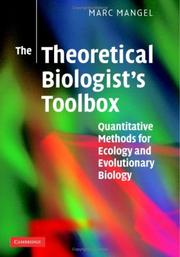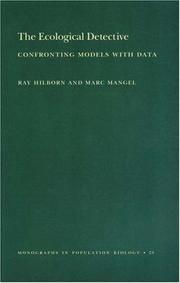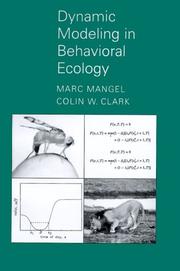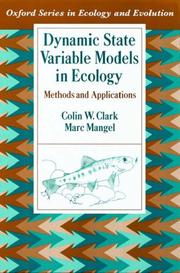| Listing 1 - 10 of 11 | << page >> |
Sort by
|
Book
ISBN: 0387159827 9780387159829 Year: 1985 Volume: 61 Publisher: Berlin Heidelberg Tokyo Springer
Abstract | Keywords | Export | Availability | Bookmark
 Loading...
Loading...Choose an application
- Reference Manager
- EndNote
- RefWorks (Direct export to RefWorks)
Fishery management --- Fishery resources --- Fisheries --- Models, Biological --- Mathematical models --- Congresses --- Congresses. --- Zoology and Animal Sciences. Aquaculture and Fisheries -- Fisheries -- Fishery Resources and Management --- ALLW. --- Fishery management - Mathematical models - Congresses --- Fishery resources - Mathematical models - Congresses --- Fisheries - congresses --- Models, Biological - congresses
Book
ISBN: 0124687202 9786612289071 1282289071 0080956777 9780124687202 9780080956770 9781282289079 Year: 1985 Volume: 172 Publisher: Orlando Academic Press
Abstract | Keywords | Export | Availability | Bookmark
 Loading...
Loading...Choose an application
- Reference Manager
- EndNote
- RefWorks (Direct export to RefWorks)
Decision and control in uncertain resource systems
Stochastic processes --- Control theory --- Dynamic programming --- Natural resources --- Renewable natural resources --- Stochastic processes. --- Control theory. --- Dynamic programming. --- Natural resources. --- Renewable natural resources. --- Natural resources, Renewable --- Renewable resources --- Resources, Renewable natural --- National resources --- Resources, Natural --- Resource-based communities --- Resource curse --- Mathematical optimization --- Programming (Mathematics) --- Systems engineering --- Dynamics --- Machine theory --- Random processes --- Probabilities --- Economic aspects

ISBN: 9780511819872 9780521830454 9780521537483 9780511648502 0511648502 0511244371 9780511244377 0511245122 9780511245121 0511819870 0521830451 0521537487 1107160529 128095616X 9786610956166 0511351682 0511566603 Year: 2006 Publisher: Cambridge [England] Cambridge University Press
Abstract | Keywords | Export | Availability | Bookmark
 Loading...
Loading...Choose an application
- Reference Manager
- EndNote
- RefWorks (Direct export to RefWorks)
Mathematical modelling is widely used in ecology and evolutionary biology and it is a topic that many biologists find difficult to grasp. In this new textbook Marc Mangel provides a no-nonsense introduction to the skills needed to understand the principles of theoretical and mathematical biology. Fundamental theories and applications are introduced using numerous examples from current biological research, complete with illustrations to highlight key points. Exercises are also included throughout the text to show how theory can be applied and to test knowledge gained so far. Suitable for advanced undergraduate courses in theoretical and mathematical biology, this book forms an essential resource for anyone wanting to gain an understanding of theoretical ecology and evolution.
Ecology --- Biology --- Evolution (Biology) --- Biological models --- Biomathematics --- Mathematical models.
Digital
ISBN: 9780124687202 0124687202 9780080956770 0080956777 1282289071 9781282289079 Year: 1985 Publisher: Orlando Academic Press
Abstract | Keywords | Export | Availability | Bookmark
 Loading...
Loading...Choose an application
- Reference Manager
- EndNote
- RefWorks (Direct export to RefWorks)
Decision and control in uncertain resource systems.

ISBN: 0691034974 0691034966 9780691034973 1299133274 1400847311 9781400847310 9780691034966 Year: 1997 Volume: 28 Publisher: Princeton, N.J. Princeton University Press
Abstract | Keywords | Export | Availability | Bookmark
 Loading...
Loading...Choose an application
- Reference Manager
- EndNote
- RefWorks (Direct export to RefWorks)
The modern ecologist usually works in both the field and laboratory, uses statistics and computers, and often works with ecological concepts that are model-based, if not model-driven. How do we make the field and laboratory coherent? How do we link models and data? How do we use statistics to help experimentation? How do we integrate modeling and statistics? How do we confront multiple hypotheses with data and assign degrees of belief to different hypotheses? How do we deal with time series (in which data are linked from one measurement to the next) or put multiple sources of data into one inferential framework? These are the kinds of questions asked and answered by The Ecological Detective. Ray Hilborn and Marc Mangel investigate ecological data much as a detective would investigate a crime scene by trying different hypotheses until a coherent picture emerges. The book is not a set of pat statistical procedures but rather an approach. The Ecological Detective makes liberal use of computer programming for the generation of hypotheses, exploration of data, and the comparison of different models. The authors' attitude is one of exploration, both statistical and graphical. The background required is minimal, so that students with an undergraduate course in statistics and ecology can profitably add this work to their tool-kit for solving ecological problems.
Biomathematics. Biometry. Biostatistics --- General ecology and biosociology --- Ecology --- Mathematical models --- Issue --- Mathematical models. --- Ecology - Mathematical models --- MONOGRAPHS --- ECOLOGY --- MATHEMATICAL MODELS
Book
ISBN: 1610918533 1610919823 1610918541 Year: 2018 Publisher: Washington, DC : Island Press/Center for Resource Economics : Imprint: Island Press,
Abstract | Keywords | Export | Availability | Bookmark
 Loading...
Loading...Choose an application
- Reference Manager
- EndNote
- RefWorks (Direct export to RefWorks)
Krill-it’s a familiar word that conjures oceans, whales, and swimming crustaceans. Scientists say they are one of most abundant animals on the planet. But when pressed, few people can accurately describe krill or explain their ecological importance. Antarctic krill have used their extraordinary adaptive skills to survive and thrive for millions of years in a dark, icy world far from human interference. But with climate change melting ice caps at the top and bottom of the world, and increased human activity and pollution, their evolutionary flexibility to withstand these new pressures may not be enough. Eminent krill scientist Stephen Nicol wants us to know more about this enigmatic creature of the sea. He argues that it’s critical to understand krill’s complex biology in order to protect them as the krill fishing industry expands. This account of Antarctic krill-one of the largest of eighty-five krill species-takes us to the Southern Ocean to learn firsthand the difficulties and rewards of studying krill in its habitat. Nicol lays to rest the notion that krill are simply microscopic, shrimplike whale food but are in fact midway up the food chain, consumers of phytoplankton and themselves consumed by whales, seals, and penguins. From his early education about the sex lives of krill in the Bay of Fundy to a krill tattoo gone awry, Nicol uses humor and personal stories to bring the biology and beauty of krill alive. In the final chapters, he examines the possibility of an increasingly ice-free Southern Ocean and what that means for the fate of krill-and us. Ocean enthusiasts will come away with a newfound appreciation for the complex ecology of a species we have much to learn from, and many reasons to protect.
Krill fisheries --- Commission for the Conservation of Antarctic Marine Living Resources. --- Fisheries --- Shellfish fisheries --- Aquatic biology. --- Ecology. --- Endangered ecosystems. --- Animal ecology. --- Wildlife management. --- Freshwater & Marine Ecology. --- Community & Population Ecology. --- Ecosystems. --- Animal Ecology. --- Fish & Wildlife Biology & Management. --- Animals --- Zoology --- Ecology --- Threatened ecosystems --- Biotic communities --- Nature conservation --- Balance of nature --- Biology --- Bionomics --- Ecological processes --- Ecological science --- Ecological sciences --- Environment --- Environmental biology --- Oecology --- Environmental sciences --- Population biology --- Hydrobiology --- Water biology --- Aquatic sciences --- Animal populations --- Game management --- Management, Game --- Management, Wildlife --- Plant populations --- Wildlife resources --- Natural resources --- Wildlife conservation --- Management --- Aquatic ecology . --- Community ecology, Biotic. --- Wildlife. --- Fish. --- Fish --- Pisces --- Aquatic animals --- Vertebrates --- Fishing --- Ichthyology --- Biocenoses --- Biocoenoses --- Biogeoecology --- Biological communities --- Biomes --- Biotic community ecology --- Communities, Biotic --- Community ecology, Biotic --- Ecological communities --- Ecosystems --- Natural communities --- Aquatic biology --- Antarctic Ocean. --- CCAMLR --- Commission pour la conservation de la faune et la flore marines de l'Antarctique --- Komissii͡a po sokhranenii͡u morskikh zhivykh resursov Antarktiki --- Comisión para la Conservación de los Recursos Vivos Marinos Antárticos --- Komissii︠a︡ po sokhranenii︠u︡ morskikh zhivykh resursov Antarktiki --- Southern Ocean

ISBN: 0691085064 0691085056 9780691085067 Year: 1988 Publisher: Princeton, N.J. University Press
Abstract | Keywords | Export | Availability | Bookmark
 Loading...
Loading...Choose an application
- Reference Manager
- EndNote
- RefWorks (Direct export to RefWorks)
Biomathematics. Biometry. Biostatistics --- Animal ethology and ecology. Sociobiology --- Automatic Data Processing. --- Behavior, Animal. --- Ecology. --- Mathematics. --- Models, Theoretical. --- 591.5 --- 591.51 --- $?$89/12 --- 57.08 --- Mathematic --- Environmental Science --- Bionomics --- Ecologies --- Environmental Sciences --- Science, Environmental --- Sciences, Environmental --- Environmental Psychology --- Conservation of Natural Resources --- Environmental Health --- Ecosystem --- Animal Behavior --- Animal Behaviors --- Behaviors, Animal --- Ethology --- Information Processing --- Bar Codes --- Computer Data Processing --- Data Processing, Automatic --- Electronic Data Processing --- Information Processing, Automatic --- Optical Readers --- Automatic Information Processing --- Bar Code --- Code, Bar --- Codes, Bar --- Data Processing, Computer --- Data Processing, Electronic --- Optical Reader --- Processing, Automatic Data --- Processing, Automatic Information --- Processing, Computer Data --- Processing, Electronic Data --- Processing, Information --- Reader, Optical --- Readers, Optical --- Computers --- Biological techniques. Experimental methods. Equipment --- Animal habits. Animal behaviour. Ecology. Ethology. Animal and environment. Bionomy --- 591.5 Animal habits. Animal behaviour. Ecology. Ethology. Animal and environment. Bionomy --- 57.08 Biological techniques. Experimental methods. Equipment --- Animal behavior --- Animal ecology --- Automatic Data Processing --- Behavior, Animal --- Ecology --- Mathematics --- Models, Theoretical --- Animals --- Zoology --- Animals, Habits and behavior of --- Animal psychology --- Ethologists --- Psychology, Comparative --- Experimental Model --- Experimental Models --- Mathematical Model --- Model, Experimental --- Models (Theoretical) --- Models, Experimental --- Models, Theoretic --- Theoretical Study --- Mathematical Models --- Model (Theoretical) --- Model, Mathematical --- Model, Theoretical --- Models, Mathematical --- Studies, Theoretical --- Study, Theoretical --- Theoretical Model --- Theoretical Models --- Theoretical Studies --- Computer Simulation --- Systems Theory --- Data processing --- Mathematical models --- Behavior --- Autotomy Animal

ISBN: 1280761067 9786610761067 0198028628 9780198028628 9781280761065 9780195122671 0195122674 9780195122664 0195122674 0195122666 019770073X Year: 2023 Publisher: New York, N.Y. ; Oxford University Press,
Abstract | Keywords | Export | Availability | Bookmark
 Loading...
Loading...Choose an application
- Reference Manager
- EndNote
- RefWorks (Direct export to RefWorks)
This is an introduction to a set of powerful and extremely flexible modelling techniques, starting at square one and continuing with chosen applications.
Animal behavior --- Animal ecology --- Animals --- Zoology --- Ecology --- Animals, Habits and behavior of --- Behavior, Animal --- Ethology --- Animal psychology --- Ethologists --- Psychology, Comparative --- Mathematical models. --- Behavior
Book
ISBN: 0691206961 Year: 2019 Publisher: Princeton, New Jersey : Princeton University Press,
Abstract | Keywords | Export | Availability | Bookmark
 Loading...
Loading...Choose an application
- Reference Manager
- EndNote
- RefWorks (Direct export to RefWorks)
This book describes a powerful and flexible technique for the modeling of behavior, based on evolutionary principles. The technique employs stochastic dynamic programming and permits the analysis of behavioral adaptations wherein organisms respond to changes in their environment and in their own current physiological state. Models can be constructed to reflect sequential decisions concerned simultaneously with foraging, reproduction, predator avoidance, and other activities. The authors show how to construct and use dynamic behavioral models. Part I covers the mathematical background and computer programming, and then uses a paradigm of foraging under risk of predation to exemplify the general modeling technique. Part II consists of five "applied" chapters illustrating the scope of the dynamic modeling approach. They treat hunting behavior in lions, reproduction in insects, migrations of aquatic organisms, clutch size and parental care in birds, and movement of spiders and raptors. Advanced topics, including the study of dynamic evolutionarily stable strategies, are discussed in Part III.
Animal behavior --- Animal behavior --- Animal ecology --- Animal ecology --- Mathematical models. --- Data processing. --- Mathematical models. --- Data processing.
Book
ISBN: 9780691206967 Year: 2019 Publisher: Princeton, NJ
Abstract | Keywords | Export | Availability | Bookmark
 Loading...
Loading...Choose an application
- Reference Manager
- EndNote
- RefWorks (Direct export to RefWorks)
| Listing 1 - 10 of 11 | << page >> |
Sort by
|

 Search
Search Feedback
Feedback About UniCat
About UniCat  Help
Help News
News